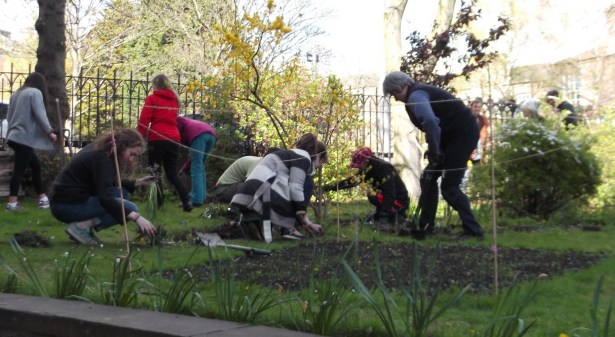
No! Forest gardening doesn’t mean a garden in a forest, nor even putting forest plants into a garden. It is about growing edible and useful plants, using the way forests grow as a model. The picture shows an urban forest garden bed being created in the middle of Dundee. Think about a wood or forest you know. It will have its canopy layer – that is the tallest trees. Just below the tree tops will be a layer of tall shrubs or small trees – this is called the understorey. The next layer is the shrub layer – small to medium bushes. Towards the edge of the woodland, and sometimes within it, there will be a layer of tall perennial plants and in most woods, a ground layer of spreading or creeping herbaceous plants. Leaf mould and composted woody material or bark lie on the ground and build up annually. Fungi colonise it. Below ground is the rhizosphere, or root layer: deep roots bringing nutrients from the mineral layer of the soil, starchy roots and tubers, bulbs and the anchoring roots of trees and shrubs.
In a forest garden, you create the same layers, but using plants that provide food, firewood, medicine or have other uses, and choosing the ones that are the right size for the site. In a big garden, the canopy layer may be nitrogen-fixing alders, heritage pears, walnuts, birches for birch sap or the versatile rowan tree for berries. In a small raised bed, the canopy may be an apple or two on dwarfing rootstock. The same apple trees, along with damsons, plums, saskatoons or hazels, could be the understorey in a big garden. whereas the wee bed might have a couple of Jostaberries and a broom for nitrogen fixing and broom-bud salad.
Many soft fruits can make up the shrub layer – from brambles to gooseberries, currants, hardy fuchsias and autumn raspberries (summer ones can be used but need something to be trained onto). Where there is enough light, shrubby herbs like winter savory or rosemary can be established, too. If the soil is a bit acidic, blueberries will thrive. Mixing species together ensures that something will always give you a crop, and there is less risk of losing the lot to birds and small mammals.
For the forest garden, or forest bed, good ground cover and eliminating non-useful coarse weeds like dock is essential. I permit a certain amount of ground elder to remain, because it tastes good, and a clump of nettles which, along with comfrey, are dynamic accumulators – feeding the soil with nutrients from below ground. These are regarded as tall perennials – I also find fennel, salad burnet and wild oregano do well in this crowded but productive setting. Skirret and burdock are perennial root vegetables occupying the tall perennial and the rootzone layers. Underneath, try wild strawberries and sweet woodruff for heavy shade, Roman chamomile and buckler-leaf sorrel for the edges, opposite-leaved golden saxifrage for wet areas. Mints are good ground cover as well – pennyroyal is not a culinary mint but smells wonderful and bees love the flowers.
There should be scope for patches of self-seeded annuals for wildlife in bigger forest garden beds – poached egg plants, nasturtiums (edible flowers) and Calendula all seem to work well. And finally, if your canopy trees are tall enough, you can grow hops, vines or other useful climbers up them. There really is a massive choice of plants to use. Martin Crawford’s excellent book, Creating a Forest Garden (ISBN 9781900322621) will take you on a deeper journey, but be careful to choose plants that will really be of use to you and that will do well in your climate and soil. My suggestions all work in my bit of Central Scotland.
Is it hard work? Using sheet mulch and leaf-mould will reduce initial weeding. For a few years you will be adjusting, adding, taking away or moving plants that don’t suit as well as you’d hoped. Some may be useful but need keeping in check – I have to put reins on the apple mint and burdock especially. But soon there will be very little to do; the space fills and there is simply no room for unwanted invaders! My advice? Start small and expand!
Join our mailing list for more advice & ideas.
Find out what plants we grow in our nursery.



 A gallon of raw milk donated to the banquet that didn’t get used is curdling in the kitchen, hopefully to become curd cheese. Ian at the church gave me a bag of apples from storage from his orchard – as I am badly missing snacks, I intend to dry some as rings to carry to work with me. Traded one of Rose’s spare cockerels for some venison, and it’s stashed in the freezer. And I am noticing the emergence of every weed – today I saw the first shoots of Ramsons or wild garlic – and remembered I have some rather rubbishy cultivated garlic in the veg plot – suddenly reject vegetables and the tops of leeks become highly desirable!
A gallon of raw milk donated to the banquet that didn’t get used is curdling in the kitchen, hopefully to become curd cheese. Ian at the church gave me a bag of apples from storage from his orchard – as I am badly missing snacks, I intend to dry some as rings to carry to work with me. Traded one of Rose’s spare cockerels for some venison, and it’s stashed in the freezer. And I am noticing the emergence of every weed – today I saw the first shoots of Ramsons or wild garlic – and remembered I have some rather rubbishy cultivated garlic in the veg plot – suddenly reject vegetables and the tops of leeks become highly desirable!